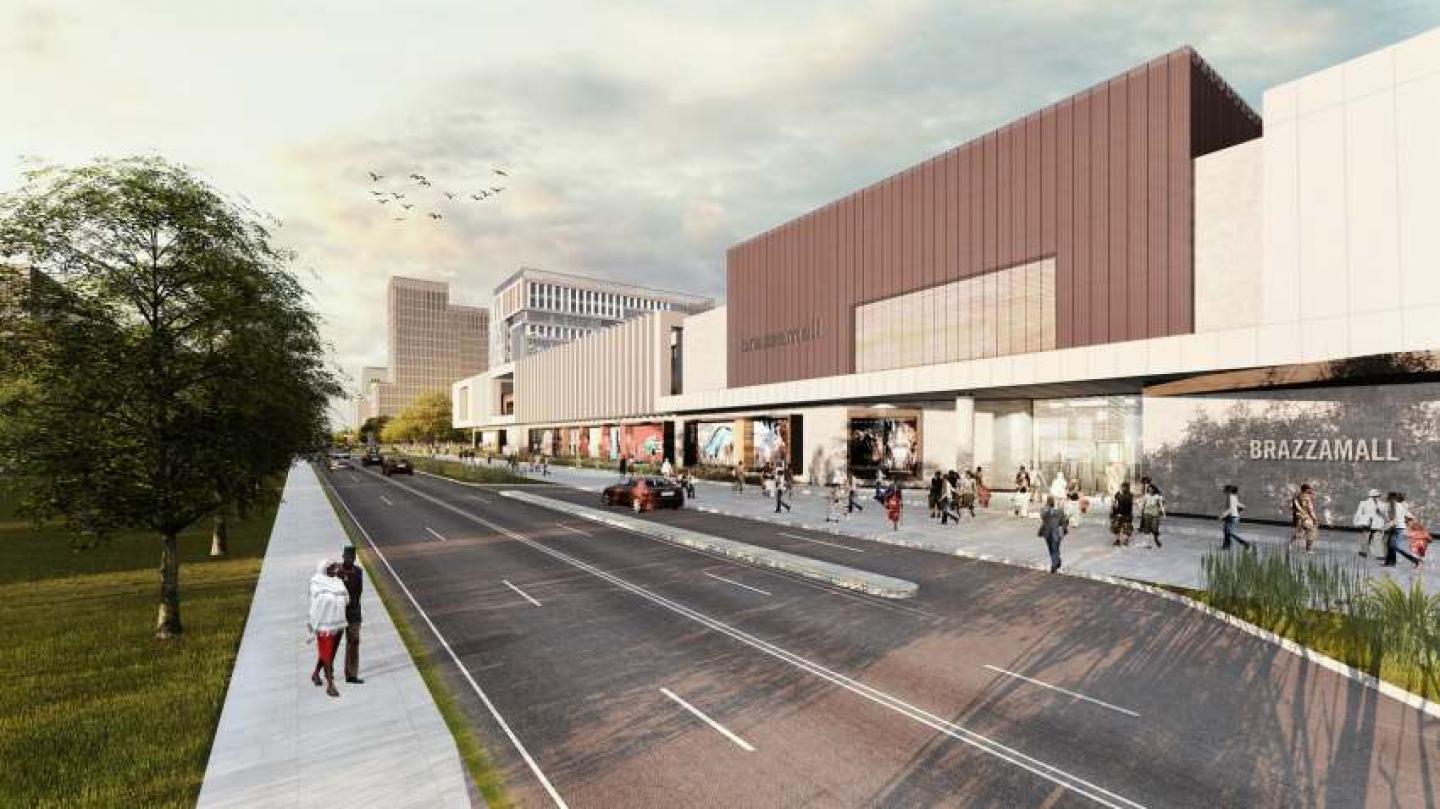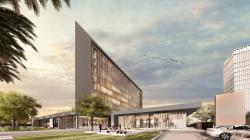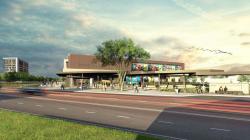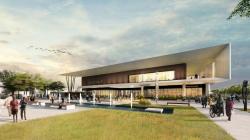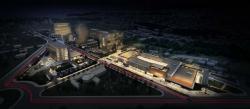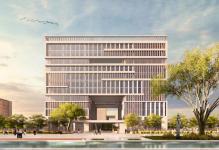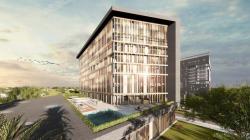PROJECT DESCRIPTION
Brazzaville City Centre Project is to be located to the south of Place de la Liberte which is the main access point to the city centre connecting the Assemblee Nationale and the Presidential Palace to the East. To the north is Boulevard Denis Sassou N’Guesso which continues along the north to Rue Lucien Fournier, which joins Avenue de L’O.U.A. , running in to Place de la Liberte from the southwest. To the south the Plateu borders the site and the Ravin de la Glaciere flowing in from the Congo River, which provides views towards a rich seam of forested land. The site also practically borders the President’s Palace which must have views restricted on to its grounds from any taller buildings.
The construction of the Cite will provide a starting point for a new kind of urbanization in Brazzaville providing circa 122,000sqm of useable office space including below ground car parking. In addition to the government complex the master plan includes a city hotel o circa 150 rooms and an area of nearly 12,000sqm and a shopping centre of 21,000 sqm including below ground car parking and 13,000sqm rentable space. The constructed area of the project totals approximately 156,000sqm
THE MASTER PLAN DESIGN APPROACH
The Cite Gouvernementale plan derives from a locational plan arrangement, which was developed for this site during an earlier phase of thinking. There fore the location of many of the main buildings and their singular typology were already defined. Also the relationship of the ministry buildings as a campus of buildings accessible from a number of gates was also defined. Our approach to the new master plan is to see it however as a major urbanisation project which has the opportunity to define the future of the Centre of Brazzaville. Thus the anchor space within the overall master plan becomes a main Public Hub / Piazza which is fronted by the main Gate Building to the East, and the new Shopping Centre to the West. To the North of the Piazza and accessible directly from Place de la Liberte as well as from the Piazza side is the new City Hotel. Thus the project not only offers public buildings accessible to all, but also a kind of formal public space that currently does not exist in Brazzaville.
The hotel placed to front on to Place de la Liberte, addresses the roundabout as a gate way building which extends its main canopy towards the axis of the roundabout. Beyond that driving further along Boulevard Denis Sassou N’Guesso and before and after the Esplanade des Droits de l’Homme are placed the two main axis of entry to the Cite Gouvernmentale, which is addressed by the tallest towers on the site. These buildings are in fact twins but have a reversed position to set themselves apart from each other. They rise to 15 floors above the ground floor and reduce and set back as they go higher to extenuate their height. The third gate is placed in axis of the Gate Building from the new Piazza to the West of the site.
The first phase of buildings to be constructed are the main Gate Building home to two main ministries, the Shopping Centre, and Hotel buildings.
CLIMATE SENSITIVE APPROACH
For at least 6-8 months of the year rain is an ever present phenomenon in Brazzaville and defines the way people interact in public and with public space. Therefore great effort was made in this sense to shelter people while out in the open but to not distance from nature, and the presence of rain because while it is raining it is still very warm and of course humid. There fore while it is important to shelter from rain it is also important to allow air to flow and cool such sheltered spaces. The presence of water is a major issue in the planning of the city as open channels are used to collect water from surface run offs.
Another aspect of the local tropical climate is the constant presence of a high level of humidity during the rainy seasons that makes use of natural ventilation as a way of minimising energy consumption difficult and the use of air conditioning of public internal spaces essential for comfort conditions to be achieved to acceptable comfort standards. Our main objective in this case is to minimise the cooling loads by reducing the incidence of sunlight on exposed glass facades. Thus glazing is always deeply set in to the façade on the north (in this case it is actually the true north façade which receives the midday sun due to the location of the site below the equator) and low sunlight from the east and west is minimised by vertical shading elements and perforated metal screens. The architecture of the buildings are all characterised by this deep layering of facades which gives us the strong vertical and horizontal accents as tools for our palatte.
Mechanical and electrical services are designed to minimise consumption by using heat recovery units, as well as zonally controlled lighting. However each building stands alone in terms of its services.
Existing trees found on site are protected as much as possible to allow fast and easy integration of landscaping and local species are planted to integrate with the existing landscape.
MINISTRY BUILDING NO 1 : THE GATE
The Gate Building stands on the Western edge of the Cite Gouvernmentale campus acting both as a physical and visual gateway to the ministries. Its main opening rising up to five floors from the West and seven floors high from the East makes a grand entry in to both the Ministry Campus as well as the new Gate Building. There are two ministries each accessed from one leg of the gate, both with its separate VIP entrances away from the public doors. The building is also accessed more privately through its basement with direct lift access to the ministers’ own offices on the top floor.
On its Eastern side directly accessed from the first Northern access gateway to the site a tall canopy welcomes visitors to both public entrances of the building. On the Western side are placed two public café/brasseries for the use ministry workers as well as the public currently within the site.
The Piano Nobile or the first floor is treated as a mezzanine, which recedes back over the main public entrances, giving tall double height spaces to the lobbies, while providing a large board room on each side. On floors above the division of space is flexible and can alter over time, however the cores of the building are designed to separate the public and private entrances so that the two never meet.
The façade composition is made up of undulating horizontal lines of stone which are interrupted and complemented by vertical accents which play with the scale of the building, and articulate it in to visually distinctive composition. External spaces are naturally created within the composition so that workers can exit on to landscaped terraces on all sides.
On the West and East facades the orientation of the vertical shading elements are altered to appropriately screen the glazing from direct sun light for most of the year, reducing the need for excessive cooling demand by adjusting to he specific orientation of each façade.
THE HOTEL
With its triangular main entrance canopy The Hotel addresses the main Place de la Liberte, touching down lightly the tangent of the circle of the round form. This canopy covers all public spaces on the ground floor and visually wraps around the whole building to form its distinctive signature in stone. The canopy is punctured at certain locations, at times to deliberately allow the rain in, and at other times to allow a tree to grow through it, while at others simply allowing daylight in to the sheltered area of the forecourt. Rain falling on to its great surface is all channelled to fall to the ground through a gargoyle at the point of the triangle where it makes contact with the ground
The Banquet Hall, which is accessed through the main lobby, is also treated as if it is an independent building with its own access from the Piazza to the South. However the functions of the Banquet Hall are fully integrated in to the hotel as it is served through a series of central kitchens. These same kitchens also serve the main restaurant to the East of the lobby while a separate bar serves the lobby bar. Both of these spaces have external terraces sheltered also by the main canopy.
The main façade elements are in metal vertical and horizontal elements again placed to provide both a depth to the façade and shelter from the sun.
SHOPPING CENTRE
The Shopping Centre is accessed from the main piazza as well as via Rue Lucien Fournier to the south of the church Saint Francois. This street promises to become a busy thorough way leading from the Avenue De Djoue, which is a main incoming public transport axis coming in to the city centre. Buses, which normally stop further up towards Place de la Liberte, are encouraged to stop on the Western side of the new shopping centre, feeding shops with footfall from both directions. This access point to the shopping centre is below the main cinema screens, which are expressed as elements in the composition. Canopies, which shelter people while they wait for transport also, lead shoppers in under cover to the second entrance.
Treated more as an urban centre, the exterior facades facing the main foot and vehicle traffic around the site, are animated with shop windows which are constantly changing. Inside the centre though small in relative terms has a sense of grandeur as the central shopping street opens up in the form of an ovoid. At one end is the super market which acts as the main anchor and on the first floor are restaurants, and general entertainment functions such as bowling, a children’s play area, and cinemas.
Shoppers arriving by car can park below the centre and rise up through lifts or escalators in to the main space. Likewise shoppers with trolleys can take their shopping directly down to car park with ramped escalators.
The main piazza façade is animated by both the bowling centre which is partly visible through a large window on the upper level, and the restaurant / bars which have terraces opening out on to the piazza.
THE PIAZZA
While it may be over stretching the statement, it is true to say that Brazzaville does not have a main public ceremonial piazza, which can act as an anchor within the city as a whole. It is hoped that this space will introduce a new typology to Brazzaville, which will resonate with its residents. Of interest is the fact that there is a distinct level change from North to South descending towards the valley made by the Ravin de la Glaciere. This allows for the space to be articulated on the vertical plane with level changes that create relatively intimate social contact spaces, and places in which the public may be expected to spend time and socially interact.
2016
0000
PROJECT DETAILS
PROJECT NAME
Brazzaville City Centre
LOCATION
brazzaville , CONGO
PROJECT TYPES
Commercial , Healthcare , Hospitality
PROJECT SCOPE
New Construction
SIZE
156,000 sq. meters
SHARED BY
AVCI Architects , AVCI Architects
PROJECT STATUS
On the Boards/In Progress
AVCI Architects
